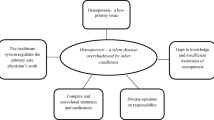Abstract
To examine messages perceived by members of an osteoporosis (OP) patient group from various healthcare providers regarding bone health. We conducted a phenomenological (qualitative) study in members of an OP patient group who resided in Canada, had sustained a fragility fracture at 50+ years old, and were not taking antiresorptive medication at the time of that fracture. Participants were interviewed for approximately 1 h by telephone and responded to questions about visits to healthcare providers for their bone health and what was discussed during those visits. We analyzed the data guided by Giorgi’s methodology. We interviewed 28 members (2 males, 26 females; 78 % response rate), aged 51–89 years old. Most participants perceived that their specialist was more interested than their primary care physician in bone health and took the time to discuss issues with them. Participants perceived very few messages from the fracture clinic and other providers. We found many instances where perceived messages within and across various healthcare providers were inconsistent, suggesting there is a need to raise awareness of bone health management guidelines to providers who treat fracture patients.
Similar content being viewed by others
References
Saadi H, Liktaker D, Mills W, Kippes C, Richmond B, Licata A (1999) Practice variation in the diagnosis and treatment of osteoporosis: a case for more effective physician education in primary care. J Womens Health Gend Based Med 8(6):767–771
Buckley LM, Marquez M, Hudson JO, Downs RW, Vacek P, Small RE et al (1998) Variations in physicians’ judgments about corticosteroid induced osteoporosis by physician specialty. J Rheumatol 25:2195–2202
Sale JEM, Beaton D, Fraenkel L, Elliot-Gibson V, Bogoch E (2010) The BMD muddle: the disconnect between bone densitometry results and perception of bone health. J Clin Densitom 13(4):370–378
Sale J, Gignac M, Hawker G, Frankel L, Beaton D, Bogoch E et al (2011) Decision to take osteoporosis medication in patients who have had a fracture and are ‘high’ risk for future fracture. BMC Musculoskelet Disord 12:92
Hibbard JH, Stockard J, Mahoney ER, Tusler M (2004) Development of the patient activation measure (PAM): conceptualizing and measuring activation in patients and consumers. Health Serv Res 39(4 Pt 1):1005–1026
Kristjansson E, Tugwell PS, Wilson AJ, Brooks PM, Driedger SM, Gallois C et al (2007) Development of the effective musculoskeletal consumer scale. J Rheumatol 34(6):1392–1400
Giorgi A (1989) Some theoretical and practical issues regarding the psychological phenomenological method. Saybrook Rev 7:71–85
Giorgi A (1997) The theory, practice, and evaluation of the phenomenological method as a qualitative research procedure. J Phenomenol Psychol 28:235–260
Giorgi A (2008) Concerning a serious misunderstanding of the essence of the phenomenological method in psychology. J Phenomenol Psychol 39:33–58
Wertz FJ (2005) Phenomenological research methods for counseling psychology. J Couns Psychol 52(2):167–177
Gearing RE (2004) Bracketing in research: a typology. Qual Health Res 14(10):1429–1452
Kvale S (1996) Interviews: An Introduction to Qualitative Research Interviewing. Sage Publications, Thousand Oaks
Nvivo [computer program]. Victoria, Australia: Qualitative Solutions and Research Pty Ltd.; 2010
Kvale S, Brinkmann S (2009) Interviews: Learning the craft of qualitative research interviewing, 2nd edn. Sage Publications Ltd., Thousand Oaks
Cicutto LC, Llewellyn-Thomas HA, Geerts WH (2000) The management of asthma: a case-scenario-based survey of family physicians and pulmonary specialists. J Asthma 37(3):235–246
Jaakkola E (2007) Physicians’ views on the influence of patient participation on treatment decisions: an exploratory study. Health Serv Manag Res 20:174–182
Douglas F, Petrie KJ, Cundy T, Horne A, Gamble G, Grey A (2012) Differing perceptions of intervention thresholds for fracture risk: a survey of patients and doctors. Osteoporos Int 23:2135–2140
Rosser WW (1996) Approach to diagnosis by primary care clinicians and specialists: is there a difference? J Fam Pract 42(2):139–144
Boyd CM, Darer J, Boult C et al (2005) Clinical practice guidelines and quality of care for older patients with multiple comorbid diseases. JAMA 294(6):716–724
Thorne SE, Nyhlin KT, Paterson BL (2000) Attitudes toward patient expertise in chronic illness. Int J Nurs Stud 37:303–311
Papaioannou A, Leslie WD, Morin S, Atkinson S, Brown J, Cheung AM et al (2010) 2010 Clinical practice guidelines for the diagnosis and management of osteoporosis in Canada. Can Med Assoc J 182(17):1864–1873
Meadows LM, Mrkonjic LA, O’Brien MD, Tink W (2007) The importance of communication in secondary fragility fracture treatment and prevention. Osteoporos Int 18:159–166
Heisler M, Bouknight RR, Hayward RA, Smith DM, Kerr EA et al (2002) The relative importance of physician communication, participatory decision making, and patient understanding in diabetes self-management. J Gen Intern Med 17:243–252
Heisler M, Cole I, Weir D, Kerr EA, Hayward RA (2007) Does physician communication influence older patients’ diabetes self-management and glycemic control? Results from the Health and Retirement Study (HRS). J Gerontol Med Sci 62A(12):1435–1442
Sale JEM, Beaton DE, Sujic R, Bogoch ER (2010) “If it was osteoporosis, I would have really hurt myself”. Ambiguity about osteoporosis and osteoporosis care despite a screening program to educate fracture patients. J Eval Clin Pract 16(3):590–596
Makoul G, Arntson P, Schofield T (1995) Health promotion in primary care: physician patient communication and decision making about prescription medications. Soc Sci Med 41(9):1241–1254
Acknowledgments
Funding for this project was provided by the Canadian Institutes of Health Research (CBO-109629). Joanna Sale was in part, funded by the Ontario Ministry of Health and Long-Term Care, OP Strategy. Views expressed are those of the researchers and not the Ministry.
Conflict of interest
The authors report no potential, perceived, or real conflict of interests.
Author information
Authors and Affiliations
Corresponding author
Rights and permissions
About this article
Cite this article
Sale, J.E.M., Hawker, G., Cameron, C. et al. Perceived messages about bone health after a fracture are not consistent across healthcare providers. Rheumatol Int 35, 97–103 (2015). https://doi.org/10.1007/s00296-014-3079-y
Received:
Accepted:
Published:
Issue Date:
DOI: https://doi.org/10.1007/s00296-014-3079-y



